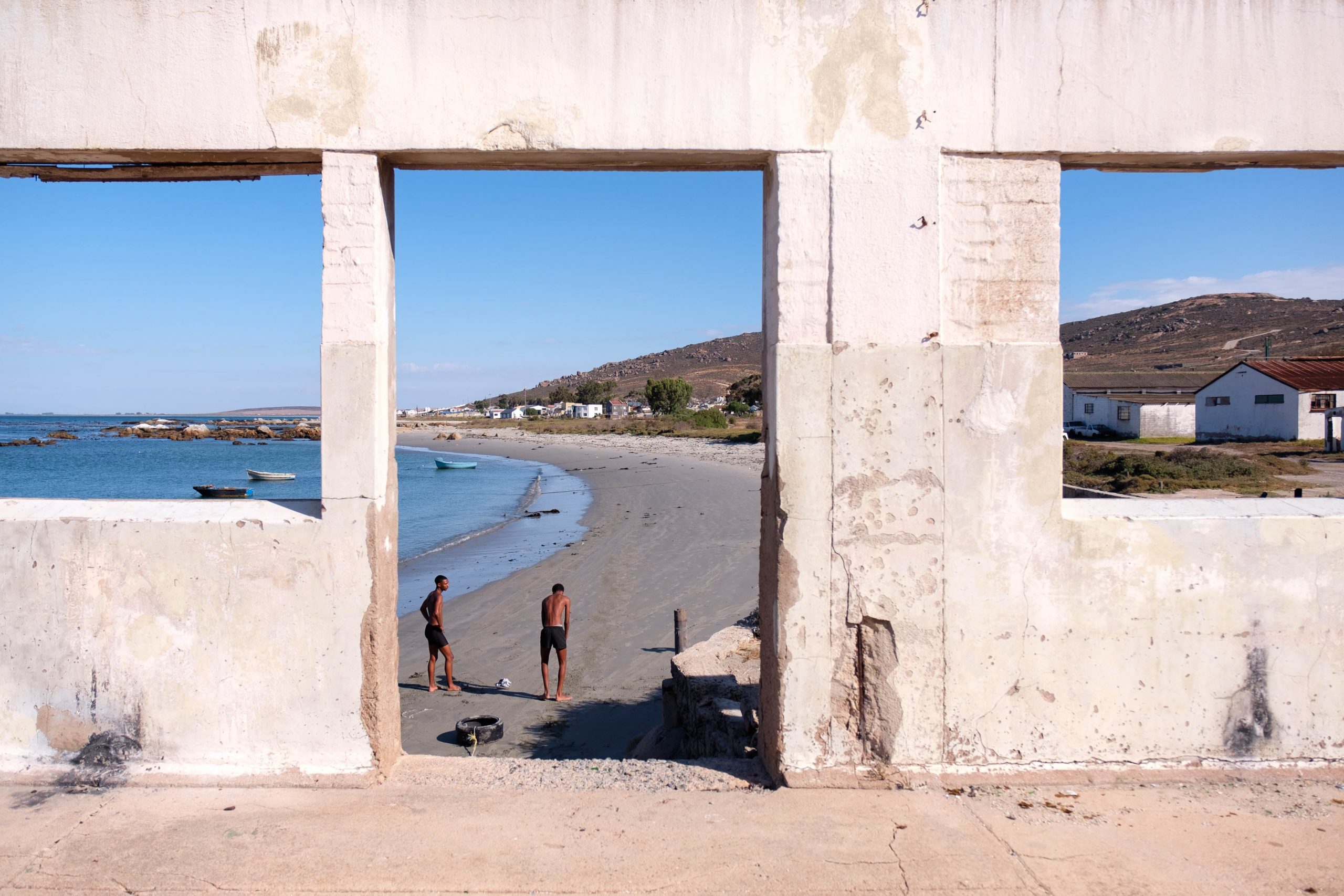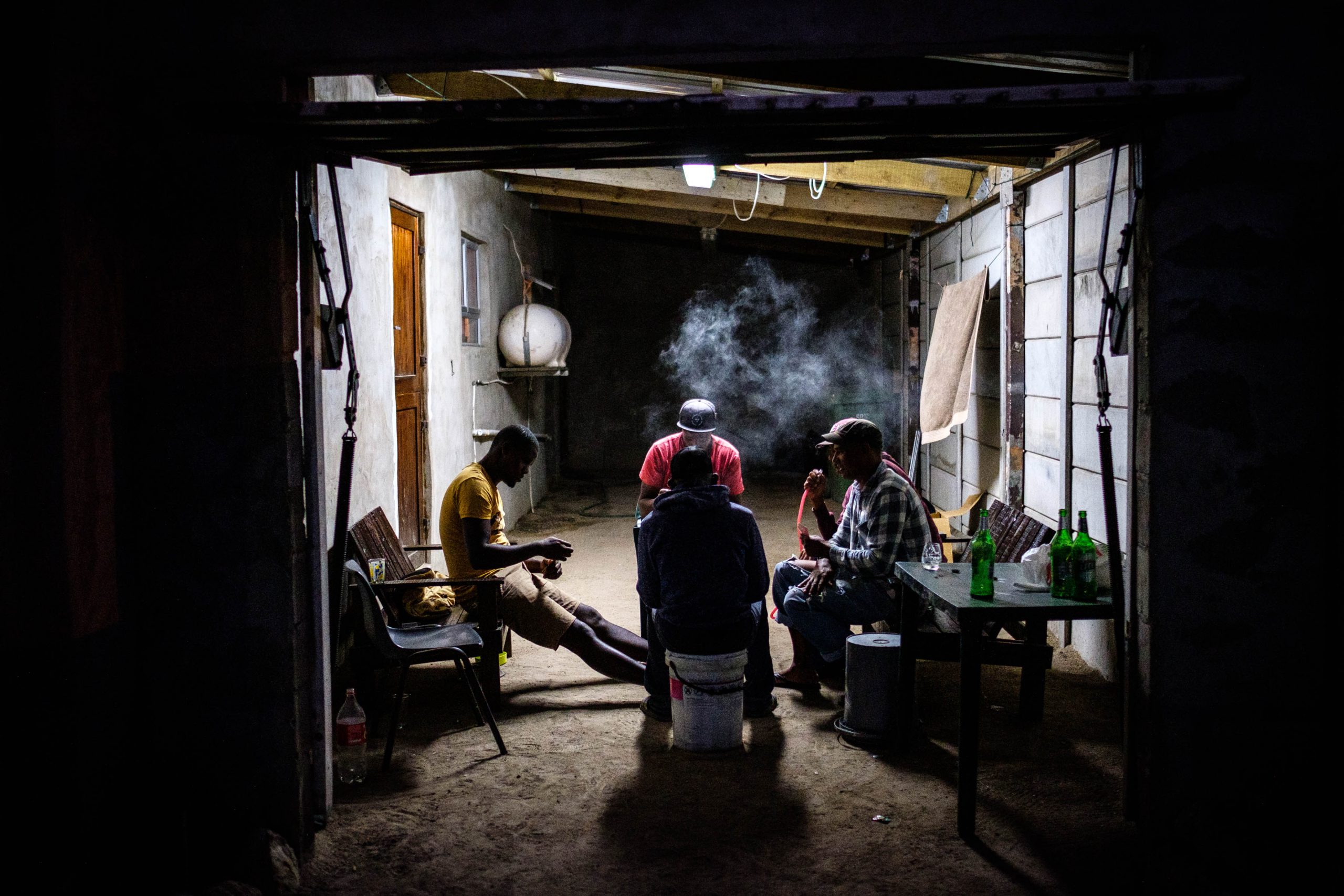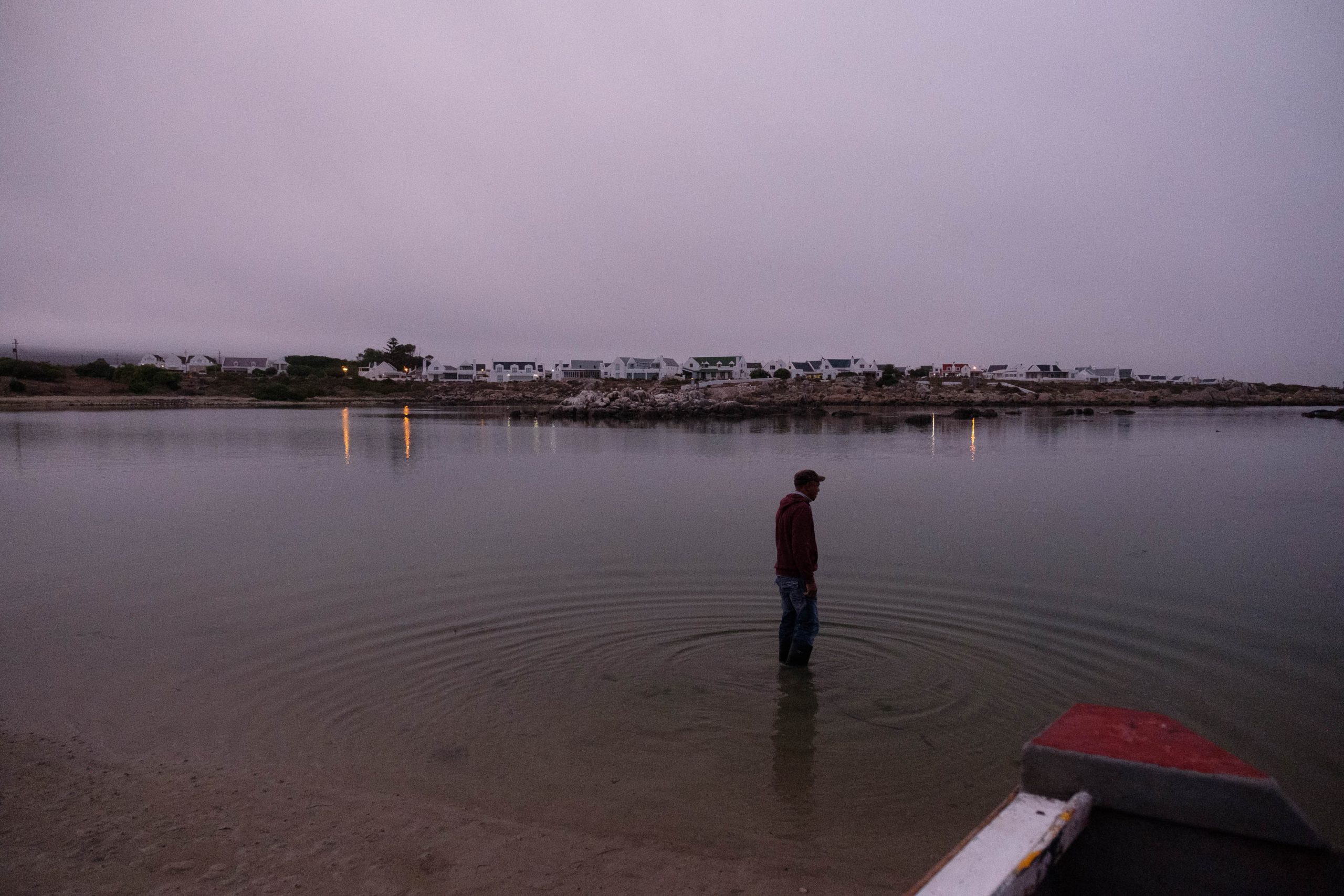Steenberg’s Cove is stuck between land and sea
Residents of the century-old fishing village on the West Coast are fighting to survive as the fishing industry declines, work remains seasonal and property developers attempt to relocate them.
Author:
10 March 2020

From the outside, the ruins of the derelict fish-canning factory in Steenberg’s Cove, a 100-year-old settlement in St Helena Bay on the West Coast, appear as a blemish on the pristine beachscape. From within, however, new ways of seeing the coast emerge that would not be possible without the framing of the rubble and the decay.
A labyrinthine collection of crumbling buildings lies scattered across the site. Since the factory’s closure 50 years ago, the harsh weather has slowly faded its off-white facade. Many of the structures are missing walls and roofs, and most have been completely emptied. In the few that still have roofs, broken glass acts as evidence that people continue to use the space; in others, tenacious vegetation has started to grow through the floors, the West Coast claiming back its land.

In the main building, the words “Ocean Fresh”, painted in white, are visible on the back wall against a faded backdrop of blue ocean waves. The large gaps missing from the tall wall to the right reveal the shimmering water of the ocean outside. Sunlight cuts through the jagged-edged gaps in the surviving roof, painting shapeshifting shadows on the windswept floor and walls.
The factory, which shut its doors in 1969, was the livelihood for many who lived in Steenberg’s Cove. It had its own harbour, allowing boats to offload their catch directly to the factory. There were machines that cut off the heads and tails of the fish and removed their entrails. Men would prepare the tomato paste and women would pack the fish and tomato paste into cans. The factory ran 24 hours a day with two shifts. Housing was provided for workers in the section of Steenberg’s Cove known as Windhoek. Stephan Brothers, the company that owned the factory, also owned all of the land in Steenberg’s Cove and much of St Helena Bay.
A long time has passed since the booming days of the St Helena Bay fishing industry. Steenberg’s Cove residents have had to adapt to the changing social and economic landscape of the area.


An ocean of stories
Oom Henny Bleeker is considered an old fisherman, having been in the trade for more than 50 years. He moved to St Helena Bay with his family when he was five years old. His father was a skipper employed by Stephan Brothers. At the age of 77, he has an ocean of stories to tell. And before we have our inevitably hour-long conversations, he always tells me that he is too busy to talk.
“In those days, fish were in abundance, West Coast rock lobster was in abundance. You got mackerel, later sardines arrived and then anchovies,” says Bleeker, speaking about the waters of St Helena Bay in the 1960s and 1970s. His eyes light up as he remembers scenes of snoek driving sardines into a frenzy, causing them to break the surface of the water and then bursting through, gorging themselves on the fish. Albatross, which followed the sardines, would also be fishing in the bay. He has not seen such scenes for years.
Back then, Bleeker would row into the bay in his “bakkie” – a two-person rowboat – to catch snoek. He’d return with so much fish that it felt as if his boat was in danger of sinking.

Bakkies remain a common sight in Steenberg’s Cove. Fishermen use them to catch haders (mullet), which they sell nearby for use as bait to catch West Coast rock lobster or for making bokkoms (dried and salted fish). This is done illegally, as residents have not managed to secure permits for catching haders.
The decline of the fishing industry on the West Coast and the reduced populations of fish available to small-scale fishers have had a devastating impact on the livelihoods of Steenberg’s Cove residents. For those who do not have small-scale fishing permits, employment opportunities are limited to irregular work in nearby canning factories and in the net-fixing industry.

Seasonal work
During the net-fixing season, green trawler nets are sprawled out on the ground outside Alnet, a net-manufacturing company based at Sandy Point Harbour, 5km from Steenberg’s Cove. Two groups of 10 to 15 women sit on foldout chairs sewing the nets. Some sit under beach umbrellas, but all of them have their heads covered to shield them from the sun. Clinton Gordon Matthews, who repairs the seams of the nets is one of the only men at the site, as net-repair is viewed largely as women’s work.
“I consider myself a fisherman,” says Matthews, while waiting on his supervisor to arrive with a special type of rope so that he can continue repairing the seam of the massive trawling net at his feet. “I am in the business of repairing nets. Without their nets, fishermen can’t catch fish.”

Matthews has been repairing fishing nets from a young age. Initially, he worked only during the school holidays, but he eventually left school in grade 9 to support his family: “My father used to drink. I needed to bring in some money to make things better at home, to help my mother and my younger brother, too.”
Since then, Matthews has become so skilled in his profession that he is hired to repair trawling nets as far away as Port Elizabeth. Despite this, the net-fixing season runs for roughly five months, from November to March, making this the only time Matthews has a reliable income. For the remaining seven months, like the other fishermen in Steenberg’s Cove, he has to hustle to make ends meet.
Matthews’ wife, a seasonal worker at a nearby sardine-canning factory, does not have a reliable income either. The factory has started canning chicken livers when sardines are scarce, but despite that she does not have work all through the year.
“If something is short at home, we go to the sea to catch something, like haders, perdevoet [limpets] or mussels. That is the only way to survive if you haven’t got work. When I’m not doing that, I will work [at Alnet] or I will do people’s hader nets.”
Matthews applied to be on the communal interim relief permit about 10 years ago, but his application was rejected. He says that if he had a West Coast rock lobster quota, he would be able to do some fishing and then take a few days off. Instead, he needs to fix nets every day that he can.

Fishers who have West Coast rock lobster quotas have their own problems, however. Small-scale fishers are allowed to work only from Monday to Friday, and may launch their boats only at sunrise. Fishing on weekends and public holidays is not allowed. Fishermen find this frustrating as they use small boats that are suited only to calmer seas, making their work dependent on the weather, which does not stick to business hours. This forces fishermen to go to sea in dangerous conditions.
Additionally, two months into the current West Coast rock lobster season, China has halted all imports from South Africa because of the coronavirus outbreak. In response, the Department of Environment, Forestry and Fisheries recently extended the West Coast rock lobster season till June and has amended fishing rights to allow small-scale fishers to work over the weekends for the rest of the season as well to mitigate the lack of Chinese trade.

Land issue
Bleeker blames Stephan Brothers’ long period of land ownership for the lack of development of other industries in Steenberg’s Cove. “You couldn’t build anything or they would put a stop to it, because it was their land.” Whatever the cause, Steenberg’s Cove residents are suffering because of the village’s overreliance on fishing. Bleeker hopes the government will develop mussel farms or aquaculture in St Helena Bay. The red tide is a problem, but he is hopeful that technological advances in filtration systems will make these interventions possible in the future.
“We will have to do it because the sea is running out of fish,” he says.
In 2006, Stephan Brothers finally sold the land to West Coast Miracles, a property development company. Contrary to the kind of development for which the residents had hoped, West Coast Miracles wants to embark on a project that requires those living in Steenberg’s Cove to move to Laingville, a nearby municipal township.

The Windhoek Gemeenskap, made up of 126 residents, opposed the eviction in the high court and won the right to stay. West Coast Miracles will appeal against the decision, but the members of Windhoek Gemeenskap want Steenberg’s Cove to be granted heritage status.
In his judgment on the matter, Judge Daniel Dlodlo said: “The occupation is almost more than a century old. This was a lawful occupation until fairly recently when the new owner, the applicant, cancelled the leases in terms of which the occupiers took occupation.”

If the right to the land was upheld for an occupation that is just over 100 years old, it does not seem far-fetched to think that the right to the sea might one day be upheld for the people who have been living off it for even longer. It might even be possible to imagine the old factory’s foundations and structures being used as a baseline for a different kind of development venture, one in which the residents have a direct stake, and one that could benefit them for decades to come.
Until that happens, people like Matthews will continue to work seasonally, supplementing their buying power by turning to the sea. Those with small-scale fishing quotas will do what they have to do to fill their quotas. The weather will continue to wear away at the remaining structures of the factory. And the sunlight will continue to pour through the ruins.

Correction, 11 March 2020: Matthews (previously referred to as Clinton Gordon) originally introduced himself as Clinton Gordon Matthews, however, the Matthews was erroneously omitted.
Update, 11 March 2020: The West coast rocklobster season has been extended till June and the weekend fishing will only be allowed until the end of the season.
